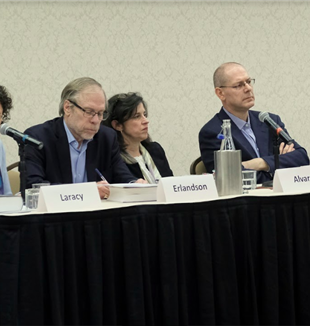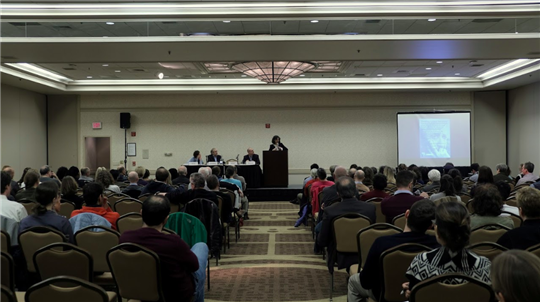
The Life of Luigi Giussani: Christ is in Reality
On March 10 at Georgetown University, Alberto Savorana spoke alongside Greg Erlandson, Helen Alvaré, and Margaret Laracy, marking the second night of the Life of Luigi Giussani book tour. Read the full story.“So, have you read it all?”
“Twice. Once in Italian, even if I wasn’t understanding all of it, and then again in English!”
As the length and heft of the book is one of the first things to strike the eye about the biography of Msgr. Luigi Giussani, the response of this friend to my question was quite surprising. But his explanation revealed the reason for this seemingly colossal feat: “Reading the biography was like having a constant dialogue with don Gius. It was like he was speaking to me, directly to me, insightfully commenting about everything that was happening in my life.”
Both distinguished speakers at the presentation of The Life of Luigi Giussani in Washington D.C. made their own comments about the sheer size of the book: according to the first speaker, Greg Erlandson, director of the Catholic News Service and accomplished journalist, the tome was like having “three kilos of Luigi Giussani.” The second speaker, Helen Alvaré, Professor of Law at George Mason University, prolific author and seasoned lay servant of the Church, humorously recounted of the many conversations that the book had started in her recent travels, as she could not fit it in her briefcase and had to carry it under her arm! However, in the cases of both speakers, what followed the quip about its size was heartfelt gratitude and wonder for the book and for the encounter with presence of Giussani that it allows, page after page after page.
Erlandson began by speaking of his encounter with Giussani and the Movement as a whole at the Meeting of Rimini of 1984. He recalled the names of many friends and described the Meeting as a display of the “openness and friendship, intellectual engagement and cultural fearlessness” that are distinctive gifts of the Movement. He described a similar impression upon meeting Giussani in Milan later that year. Erlandson dwelled particularly on a kind of summary that Giussani, in that conversation, offered of his work and of the work of Communion and Liberation: the mission “to rouse the sleeping ones.” According to the journalist, this is the challenge that Giussani faced and that the Church still faces. “God has no grandchildren,” he said. “We are either sleepwalkers or adults who have made a choice about our faith.”
And what is able to rouse us from our sleep and to make us “adults in the faith,” as was Giussani’s almost obsessive goal? Tradition and theory do not suffice; only an encounter with Christ, with the “power of a presence”, can do these things. As the biography testifies and Erlandson evoked, that presence was the main focus of Giussani. “We begin again from One,” as Giussani had said after the Italian referendum that legalized abortion. We begin again only from the presence of Christ among us, because this is the only thing capable of creating lasting faith and true education of the heart. As a final note, Erlandson dwelled on Giussani’s unique capacity to express the passion he lived for Christ: “Giussani was a poet. In this time of crisis, we need saints, yes. But we need saints who are poets.”
Alvaré spoke about how the encounter with Giussani intercepted her own wrestling with faith and with the biggest questions of life. She spoke of the light shed on her personal life, especially as a parent, and her professional life, in the 35 years she has spent working with the Church.
For her life as an educator, Giussani challenged her to see that the communication of the faith cannot begin from pride nor from fear, but only from a personal experience of Christ as a source of freedom. Only such an experience, she said, allows for a constant dialogue of comparison between the proposal of the world and the Christian proposal. Instead, speaking about the years she spent working for the USCCB, Alvaré recounted her gratitude for being able, thanks to this encounter, to focus on the person even within bureaucratic work. Her third point was on the “peril of moralism” when speaking about hot-button issues such as abortion or divorce, as her work as led her to so often do. “Our answer to these issues cannot lie on saying ‘No, you cannot’,” she remarked. There is a different approach, which she illustrated with an enthusiastically recounted story of Giussani’s chance meeting with a couple kissing in an alley. To the surprise of the boy and the girl, no remonstrance came from the lips of the priest, but only a simple question: “What you were just doing: what does it have to do with the stars?” This can be the shape of our presence in the world and in society, Alvaré went on to say: we can testify to the fact that “we are a community that witnesses to the fullness of love, which truly builds community.”
In her final remarks, Alvaré spoke of Giussani’s unrelenting emphasis on obedience to the Church, notwithstanding all of the difficulties and challenges that such action could create. Her remarks were especially poignant given the climate of crisis and challenge in the Church that we face today. Giussani showed us that “authority is part of the structure of the Church and part of our vocation is to live obedience, within a constant dialogue”, just as Giussani always lived with his bishops and with the pope. It is an obedience, ultimately, to reality, as moderator Margaret Laracy pointed out, paraphrasing Alvaré’s reflection, because “Christ is in reality, speaking to us through signs.”
As she was making her final comments, Alvaré’s desire to continue to speak about her experience of working on the book was apparent, notwithstanding the fact that she was going over her allotted time, as she humorously pointed out. It was a small illustration of the abundance that both speakers, as well as Alberto Savorana, testified to in their discussion of the Life of Fr. Giussani. It is the abundance that flows from encountering such a witness, as Fr. Giussani continues to be for those who follow him and for the Church as a whole. The Life of Luigi Giussani continues to allow us to meet this man, who, communicating his passion for Christ and for the destiny of mankind, is able “rouse the sleeping ones” and to help us in our journey towards being adults in the faith. #LifeLuigiGiussani